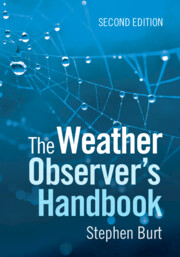Book contents
- The Weather Observer’s Handbook
- Reviews
- The Weather Observer’s Handbook
- Copyright page
- Dedication
- Epigraph
- Contents
- Foreword
- Acknowledgements
- Author’s note
- Abbreviations, footnotes and references
- Part I The basics
- Part II Measuring the weather
- 4 Site and exposure: The basics
- 5 Measuring the temperature of the air
- 6 Measuring precipitation
- 7 Measuring atmospheric pressure
- 8 Measuring humidity
- 9 Measuring wind speed and direction
- 10 Measuring grass and earth temperatures
- 11 Measuring sunshine and solar radiation
- 12 Observing hours and time standards
- 13 AWS data flows, display and storage
- 14 Non-instrumental weather observing
- 15 Calibration
- 16 Metadata: What is it, and why is it important?
- Part III Making the most of your observations
- Book part
- References and Further Reading
- Index
8 - Measuring humidity
from Part II - Measuring the weather
Published online by Cambridge University Press: 21 May 2024
- The Weather Observer’s Handbook
- Reviews
- The Weather Observer’s Handbook
- Copyright page
- Dedication
- Epigraph
- Contents
- Foreword
- Acknowledgements
- Author’s note
- Abbreviations, footnotes and references
- Part I The basics
- Part II Measuring the weather
- 4 Site and exposure: The basics
- 5 Measuring the temperature of the air
- 6 Measuring precipitation
- 7 Measuring atmospheric pressure
- 8 Measuring humidity
- 9 Measuring wind speed and direction
- 10 Measuring grass and earth temperatures
- 11 Measuring sunshine and solar radiation
- 12 Observing hours and time standards
- 13 AWS data flows, display and storage
- 14 Non-instrumental weather observing
- 15 Calibration
- 16 Metadata: What is it, and why is it important?
- Part III Making the most of your observations
- Book part
- References and Further Reading
- Index
Summary
The term ‘humidity’ refers to the amount of water vapour in the air. The physics of water vapour is one of the main components of the atmospheric heat engine which produces ‘weather’ and as a result, humidity measurements are an essential requirement for operational meteorological analysis and forecasting, for climate studies, hydrology, agriculture and many other areas of human activity and comfort. In the meteorological context, the terms relative humidity (RH) and dew point (Td) are most often used in specifying atmospheric water vapour content. This chapter sets out how humidity measurements are made, following guidelines laid down by the World Meteorological Organization in the so-called CIMO guide (Commission for Instruments and Methods of Observation), including those from chilled mirror hygrometers, a dry and wet bulb psychrometer and electronic humidity sensors. Limitations of existing methods in some circumstances, such as air temperatures below freezing point, are covered.
Keywords
Information
- Type
- Chapter
- Information
- The Weather Observer's Handbook , pp. 204 - 216Publisher: Cambridge University PressPrint publication year: 2024
